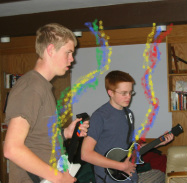
The most common form of synesthesia is seeing the different letters and numbers as each having a very specific color, and each synesthete has his or her own color coding system. This is the form of synesthesia that Mia has in Wendy Mass’ novel, A Mango-Shaped Space. (See my book review.) While this fictional account of the phenomenon of synesthesia is interesting, it was even better to “meet” real synesthetes through their reviews of the book on Amazon.com.
According to a synesthesia website one of these reviewers recommended, about 1% of the population is
blessed with this ability. Synesthetes would not call it a defect, anomaly, or bug in their software. For the most part they are quite pleased to have this extra creative ability, and often become artists and musicians perhaps because if it.
I remember back in grade school when we were asked to do a blind taste test of various edibles. One kid
said toothpaste tasted green. We all laughed because green isn’t a taste, but we also understood what he meant. Mint is green; they go together, mint and green. I wish I still knew him so I could ask him if he’s a real synesthete. Maybe I could sit down with him over a couple of beers and try to understand what it’s really like.
But maybe we all have a bit of this special feature. Mint does taste green, sort of. Colors can be loud, a term usually reserved for sounds. Cheddar cheese can be sharp and whisky can be smooth – both tastes that have textural adjectives. A person can have an abrasive personality, or a sunny one. Our language is full of synesthetic phrases that most of us understand to some degree or another.
I became so fascinated that I dug up the non-fiction book, The Tell-Tale Brain: A Neuroscientist’s Quest for What Makes Us Human by V.S. Ramachandran. (I read it cover to cover, and talked about it way too much to people who really weren’t that interested. Sorry, folks.)
The small portion of the book that was about synesthesia put forth the hypothesis that all the different sensory portions of our brain – smell, taste, sight, hearing, touch – are adjacent to one another in the brain. As fetuses and infants we have a lot of networking going on between different areas of the brain. Too much networking. Some of these neural highways need to be pared back as we learn from experience how to interpret all the sensory inputs that bombard us every second. Synesthetes, the theory goes, didn’t pare back their neural highways as much as the rest of us during development, leaving some “unnecessary” roads intact. Maybe a visual input goes to both a visual and an auditory section of their brain, so they hear colors in addition to seeing them.
As often happens when I become obsessed with a topic, I ran across synesthesia in a whole different arena, my Science News magazine. Ayumu, a chimpanzee, has become legendary for performing a number-ordering feat faster than any human. Scientists flash numbers 1 through 9 on a computer screen in random order for only a split-second, and then replace them with white boxes. The chimp then uses his finger to rapidly put them in numeric order. While it’s just speculative, they are wondering if this chimp is a synesthete who sees numbers in unique colors. Human experiments show that seeing numbers in color would give him an edge over the rest of us, perhaps leaving an afterglow of the color when the number disappeared. Then again, maybe Ayumu is just better than humans at seeing and sorting plain old black numbers. It could happen.
So, is anybody out there a synesthete? Care to share your story?
